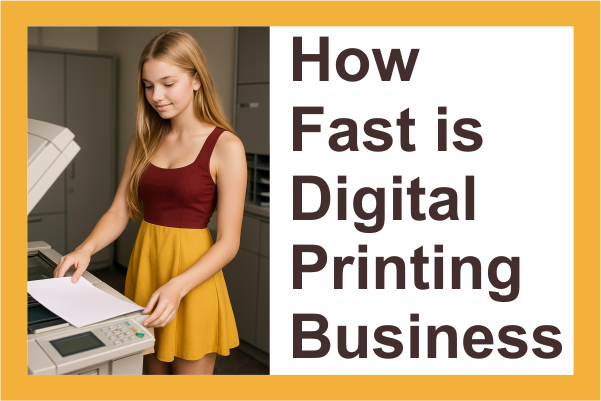Fast is Digital printing has transformed the way we produce printed materials. Unlike traditional printing methods, digital printing offers a speedy process that allows businesses and individuals to create high-quality prints with remarkable efficiency. Whether you’re printing brochures, flyers, business cards, or large format graphics, understanding the speed of digital printing can be crucial to achieving your goals. In this blog post, we’ll explore what digital printing is, how it compares to traditional methods, the factors that can affect its speed, and its implications for businesses.
Introduction
In today’s fast-paced environment, speed is crucial in nearly every facet of business, including printing. As organizations strive to keep up with demands, they often turn to digital printing as a solution. But just how fast is digital printing? In this post, we will examine the efficiency of digital printing methods, compare them with traditional printing approaches, and discuss factors that influence speed.
Understanding Fast is Digital Printing
Definition of Digital Printing
Fast is Digital printing refers to the method of printing directly from a digital file to a variety of media. This includes printing methods that require no printing plates or manual color adjustments, which makes it suitable for quick turnaround times and low to medium print runs.
Types of Digital Printing Technologies
There are several types of fast is digital printing technologies, each with its unique benefits:
Inkjet Printing:
Utilizes tiny nozzles to spray ink onto the media. Inkjet printers are known for their color accuracy and are often used for high-quality images.
Laser Printing:
Employs laser technology to transfer toner onto paper. Laser printers are usually faster than inkjet printers and are ideal for text-heavy documents.
UV Printing:
Uses ultraviolet light to cure ink as it is printed. This method allows for printing on a variety of materials, including non-absorbent surfaces.
Dye-sublimation Printing:
Primarily used for fabric products, dye-sublimation printing involves converting solid dye into gas that embeds into the material, resulting in vibrant color reproduction.
Comparing Speed: Digital vs. Traditional Printing
Overview of Traditional Printing Techniques
Traditional printing methods, such as offset and flexographic printing, involve several processes that can slow down production. These include creating printing plates, setting up the press, and adjusting inks.
Speed Comparison
Generally, digital printing could be faster for shorter runs, while traditional methods might produce higher volume prints more efficiently after setup. For instance, print jobs under 1,000 units may be completed more quickly via digital means. Cost and quality considerations also play significant roles in determining the best method for specific projects.
Factors Affecting Digital Printing Speed
Several factors influence the fast is digital printing, making it essential to understand these elements to optimize efficiency.
Print Volume
Higher volumes can markedly slow down digital printing. While it excels in short runs, printing numerous copies can take significant time due to processing limitations and batch handling.
Print Quality
Higher print quality settings can increase printing time. Whether it’s detailed images or specific color profiles, achieving the desired quality may take longer, impacting overall speed.
Types of Materials
Different substrates and printing materials can affect how quickly a printer can operate. Specialty materials may require additional time for setup or drying.
Printer Specifications
The specifications of the digital printer itself – such as speed output, resolution capability, and ink type – profoundly influence the speed of print jobs. Advanced models often provide enhanced efficiency.
The Benefits of Fast is Digital Printing
Investing in fast is digital printing offers numerous advantages for businesses, particularly those in competitive industries.

Time Efficiency
The speed with which digital printing enables quick turnaround projects is unparalleled, saving time for businesses and improving customer satisfaction.
On-Demand Printing
The fast is Digital printing allows for on-demand production, which means businesses can print materials as needed without tying up resources for large print runs.
Cost-Effectiveness
While traditional printing may appear cost-effective for large quantities, digital printing’s lower setup costs make small batches more economical.
Short Run Capabilities
Digital printers maintain high quality even for low-volume print runs, providing flexibility for businesses needing diverse marketing materials.
Real-World Applications of Fast Digital Printing
Fast digital printing has opened doors in various applications across industries.
Commercial Printing
Businesses can quickly produce high-quality marketing materials, product pamphlets, and print advertising campaigns.
Personalized Marketing Materials
With digital printing, companies can easily target specific audiences by personalizing materials, such as direct mail advertising, at high speeds.
Packaging
Digital printing is transforming packaging by enabling shorter runs of custom designs while maintaining production speed
Textiles and Apparel
This method is widely used in customizing apparel, allowing the fast production of fashion items and promotional products.
Future Trends in Digital Printing Speed
As technology continues to evolve, the future of digital printing looks promising.
Innovations in Technology
Continued advancements in digital printing technology, such as faster drying inks and print heads, will significantly increase overall printing speeds.
Industry Predictions
Experts predict that as digital printing becomes more integrated with e-commerce, its speed and efficiency will improve, allowing businesses to respond rapidly to changing market demands.
Conclusion
Digital printing’s speed is one of its most transformative features, providing businesses with an edge in today’s competitive landscape. By understanding the factors that affect printing speeds and the advantages of digital technologies, organizations can streamline their printing processes efficiently. In a world where time is money, embracing the pace of digital printing can unlock greater opportunities for success.

